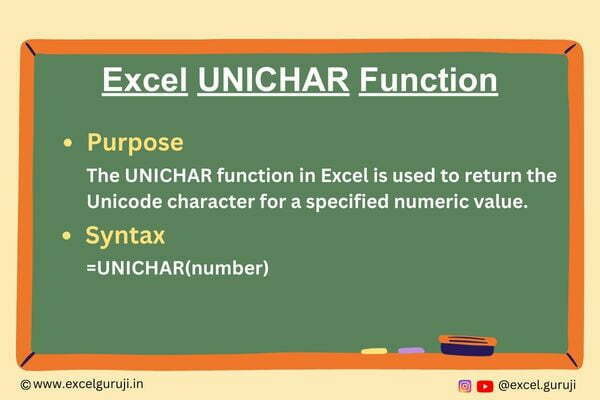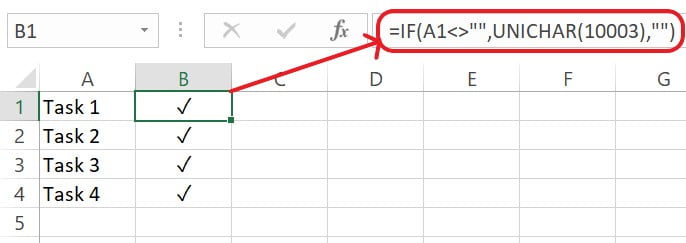Contents
- 1 Excel UNICHAR Function
- 2 When to Use the Excel UNICHAR Function in Excel
- 3 What Excel UNICHAR Function Returns
- 4 Syntax of Excel UNICHAR Function
- 5 Input Arguments
- 6 Extra Notes
- 7 Common Mistakes to Avoid
- 8 Tips For Optimal Usage
- 9 Examples of the Excel UNICHAR Function
- 10 Conclusion
- 11 Frequently Asked Questions (FAQs)
Excel UNICHAR Function

When to Use the Excel UNICHAR Function in Excel
The UNICHAR function in Excel comes in handy when you need to display special symbols, emojis, or characters that are not readily available on your keyboard. Whether you are creating a data visualization, designing a dashboard, or simply adding a touch of creativity to your Excel sheets, the UNICHAR function can help you achieve your goals.
What Excel UNICHAR Function Returns
The Excel UNICHAR function returns a single Unicode character based on the numeric Unicode value you provide as its argument. This function makes it possible to display characters that might otherwise be inaccessible through regular typing.
Syntax of Excel UNICHAR Function
The syntax of the Excel UNICHAR function is following:
=UNICHAR(number)
Input Arguments
Here’s what you need to know about the input arguments for the Excel UNICHAR function:
👉 number: This is a required argument representing the Unicode value of the character you want to display. It can be an actual number, a cell reference containing the numeric value, or a formula that evaluates to a numeric value.
Extra Notes
👉 The Excel UNICHAR function is particularly useful when working with non-Latin scripts, special symbols, and emojis, as it allows you to easily incorporate these characters into your Excel documents.
👉 Excel supports a wide range of Unicode characters, making it a versatile tool for handling multilingual data and creating visually appealing documents.
👉 While the UNICHAR function converts a Unicode code point into a character, you can also use the CHAR function to display characters based on their ASCII values. The CHAR function is suitable for working with basic alphanumeric characters.
Common Mistakes to Avoid
👉 Incorrect Unicode Values: Ensure that the number argument corresponds to a valid Unicode value. Using an invalid or out-of-range value will result in an error.
👉 Non-Numeric Values: The number argument must be a numeric value. Using text or non-numeric values will result in an error.
👉 Unsupported Characters: Not all Unicode characters are supported in all fonts or systems. Test the display of your chosen character in your specific environment.
Tips For Optimal Usage
To enhance your Excel skills and efficiently use the UNICHAR function, consider these tips:
👉 Use CHAR Function: The CHAR function is similar to UNICHAR but works with the legacy character set (ASCII). Combine UNICHAR with CHAR to cover a broader range of characters.
👉 Unicode Resources: Explore online resources and charts that provide lists of Unicode characters and their corresponding values. This can help you discover unique characters to use in your Excel documents.
Examples of the Excel UNICHAR Function
Let’s explore a few examples to understand how to use the UNICHAR function effectively:
Example 1: Displaying Special Symbols
Suppose you want to display the copyright symbol (©) in cell A1. You can use the UNICHAR function as follows:

Example 2: Creating a Checkmark List
In column A, list items you want to check off, and in column B, use the following formula to display a checkmark (✓) when an item is complete:

Now let’s break down the formula step by step:
(1) IF(A1<>””, … , “”)
- This is an Excel IF function. It checks if cell A1 (the corresponding cell in column A) is not empty. If it’s not empty, it performs the action specified in the first part of the formula. If it is empty, it displays an empty string (“”), which means the cell will be blank.
(2) UNICHAR(10003)
- If cell A1 is not empty (i.e., there’s something in the checklist item), this part of the formula uses the UNICHAR function to display the Unicode character for a checkmark (✓), which is represented by the Unicode value 10003.
Example 3: Creating a Custom Star Rating
In column A, list ratings from 1 to 5, and in column B, use the following formula to display star ratings

Now, let’s break down this formula
(1) UNICHAR(9733)
- This part of the formula uses the UNICHAR function to display a filled star symbol (★), represented by the Unicode value 9733.
(2) UNICHAR(9734)
- This part of the formula uses the UNICHAR function to display an empty star symbol (☆), represented by the Unicode value 9734.
(3) REPT(UNICHAR(9733), A1)
- This part repeats the filled star symbol ★ A1 times, where A1 contains the rating value. For example, if the rating is 3, it will repeat the filled star symbol three times (★★★).
(4) REPT(UNICHAR(9734), 5 – A1)
- This part repeats the empty star symbol ☆ (5 – A1) times, filling the remaining space to make a total of 5 stars. For example, if the rating is 3, it will repeat the empty star symbol twice (☆☆).
For a comprehensive collection of Unicode symbols and characters, including emojis, mathematical symbols, and more, you can explore the ‘Huge List of Unicode Symbols‘ provided by Vertex42. Whether you’re looking to enhance your text with special characters or simply curious about the world of Unicode, this resource offers a wide range of options.
Conclusion
In conclusion, the Excel UNICHAR function is a valuable tool for working with Unicode characters, symbols, and emojis in your Excel spreadsheets. It opens up a world of possibilities for enhancing the visual appeal of your data and documents, allowing you to communicate effectively and creatively.
Don’t hesitate to explore the vast Unicode character set and experiment with different characters to make your Excel projects more engaging and informative. Start using the UNICHAR function today and unlock the full potential of character representation in Excel.
Frequently Asked Questions (FAQs)
Q1: Can the UNICHAR function be used to convert characters back into Unicode code points?
A1: No, the UNICHAR function is specifically designed to convert Unicode code points into characters. To convert characters back into Unicode code points, you would need to use a different method or function.
Q2: Are there limitations to the range of Unicode code points that the UNICHAR function can handle?
A2: The UNICHAR function can handle Unicode code points ranging from 1 to 1114109 covering the entire Unicode character set. However, it is essential to ensure that you provide a valid code point within this range.
Q3: Can I use the UNICHAR function to display emojis in Excel?
A3: Yes, you can use the UNICHAR function to display emojis in Excel. Emojis are represented by specific Unicode code points, and you can use the UNICHAR function to convert these code points into emoji characters.
Q4: Does the UNICHAR function support all languages and writing systems?
A4: Yes, the UNICHAR function supports characters from all languages and writing systems represented in the Unicode standard. It can display a wide range of characters, including those from non-Latin scripts and special symbols.
Q5: Is there a limit to the number of characters that can be displayed using the UNICHAR function in a single cell?
A5: The UNICHAR function can display one character per cell. If you want to display multiple characters, you would need to use multiple cells or concatenate the characters using other Excel functions.
Other Related Excel Functions
Join me on Instagram and YouTube for your daily dose of valuable tips and tricks! Catch insightful videos that will enhance your knowledge and skills. Don’t miss out – follow me now!